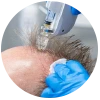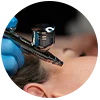Dermapen® 4 - Special Offer
Advanced Stimulation for Skin Repair
What to Expect?
From Microneedling



Revitalised Skin
Improved Texture
Reduced appearance of scars and wrinkles with Microneedling's skin regeneration process
Rejuvenated Appearance
Restore a smoother, firmer look with Microneedling's natural healing stimulation
FAQ
About MicroneedlingMicroneedling with Dermapen 4 is a cosmetic procedure that involves using a handheld device called a Dermapen to create controlled micro-injuries on the skin. The Dermapen has a series of tiny needles that penetrate the skin at a controlled depth, creating small punctures in the skin's surface.
These micro-injuries trigger the skin's natural healing response, stimulating collagen and elastin production. The increased collagen and elastin production help to improve the skin's texture, reduce the appearance of fine lines and wrinkles, and minimise the appearance of scars and hyperpigmentation.
The Dermapen can be used on the face, neck, and other parts of the body to improve the overall appearance and texture of the skin. The procedure is typically performed by a licensed skincare professional, who will use a numbing cream to minimise any discomfort.
After the procedure, the skin may appear slightly red and feel slightly tender, similar to a mild sunburn. However, any discomfort typically subsides within a few hours to a day, and patients can usually resume their normal activities immediately following the procedure.
Multiple sessions of microneedling with Dermapen may be required to achieve optimal results, and a personalised treatment plan will be created for each patient based on their individual skin concerns and goals.
Microneedling with a Dermapen can cause some level of discomfort, but it is usually well-tolerated by most people. The level of pain or discomfort experienced during the procedure can vary depending on the individual's pain tolerance, the depth of the needles used, and the area of the body being treated.
During the procedure, a numbing cream is applied to the skin to minimise any discomfort. However, some people may still feel a sensation of prickling, burning, or mild pain during the procedure.
It's important to note that the pain or discomfort experienced during the microneedling procedure is temporary and usually subsides shortly after the treatment is completed. After the procedure, the skin may feel slightly tender, swollen, or sensitive, but these symptoms usually resolve within a few days.
Overall, while there may be some discomfort during the microneedling procedure, many people find the results well worth it and report that the pain is manageable.
Here are some of the conditions that may make a person a suitable candidate for microneedling with Dermapen:
- Fine lines and wrinkles: Microneedling can stimulate collagen production, which can help reduce the appearance of fine lines and wrinkles.
- Acne scars: Microneedling can improve the appearance of acne scars by breaking up scar tissue and stimulating the production of new collagen.
- Hyperpigmentation: Microneedling can help reduce the appearance of hyperpigmentation by promoting the turnover of skin cells.
- Uneven skin texture: Microneedling can help improve the texture of the skin by promoting the growth of new collagen and elastin.
- Large pores: Microneedling can help reduce the appearance of large pores by stimulating collagen production and tightening the skin.
- Stretch marks: Microneedling can help improve the appearance of stretch marks by stimulating collagen production and promoting the growth of new skin cells.
It is important to note that not everyone is a suitable candidate for microneedling with Dermapen. People who have active skin infections, open wounds, or severe eczema or psoriasis should not undergo this procedure. Additionally, people who have a history of keloid scarring or who are taking certain medications, such as blood thinners, may not be suitable candidates for microneedling. It is always best to consult with a qualified healthcare professional or licensed aesthetician to determine if microneedling is right for you.
The number of microneedling with Dermapen treatments needed can vary depending on the individual and the specific skin concerns being addressed. In general, a series of 3 to 6 treatments spaced about 4 to 6 weeks apart is recommended for optimal results.
However, the exact number of treatments needed can depend on factors such as the severity of the skin concerns, the patient's age, the patient's skin type, and the patient's lifestyle factors (such as sun exposure, smoking, and alcohol consumption).
It is also important to note that maintenance treatments may be needed to maintain the results of microneedling with Dermapen. This can involve getting a treatment every 6 to 12 months, or as recommended by your healthcare provider or licensed aesthetician.
It's important to have a consultation with a qualified healthcare professional or licensed aesthetician to determine the recommended number of treatments based on your specific needs and skin concerns.
The length of a microneedling with Dermapen treatment can vary depending on the size of the treatment area and the intensity of the treatment. In general, a single treatment session can take anywhere from 30 minutes to 1 hour.
Before the procedure, the skin is typically cleansed and numbing cream may be applied to help minimise discomfort. The Dermapen device is then used to make small, controlled punctures in the skin, creating micro-channels that allow for the absorption of topical serums and stimulate the production of collagen and elastin.
After the treatment, a soothing serum or moisturiser may be applied to the skin to help reduce redness and irritation. Some people may experience mild swelling, redness, and sensitivity in the treated area for a few days after the procedure, but these side effects typically resolve within a week.
The recovery time for microneedling with Dermapen can vary depending on the individual and the intensity of the treatment. In general, the recovery time is relatively short, with most people experiencing mild redness, swelling, and sensitivity for 1 to 3 days following the procedure. Some people may also experience mild peeling or flaking in the treated area, which typically resolves within a week.
During the recovery period, it is important to protect the treated area from sun exposure, avoid applying makeup or other products that may irritate the skin, and follow any aftercare instructions provided by your healthcare provider or licensed aesthetician. This may include using gentle cleansers and moisturisers, avoiding harsh scrubs or exfoliants, and applying sunscreen with a high SPF to protect the skin from UV damage.
Most people are able to resume their normal activities within a day or two of the treatment, but it is important to avoid intense physical activity, saunas, and hot tubs for a few days to minimise the risk of infection and other complications.
Our Microneedling Practitioners

Silvia

Cristina

Mariana








